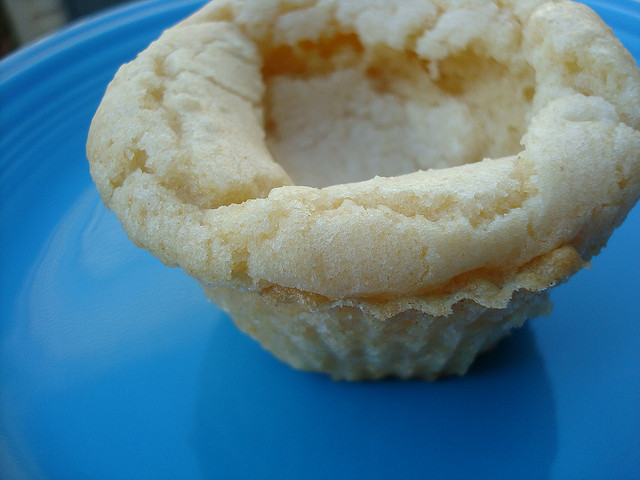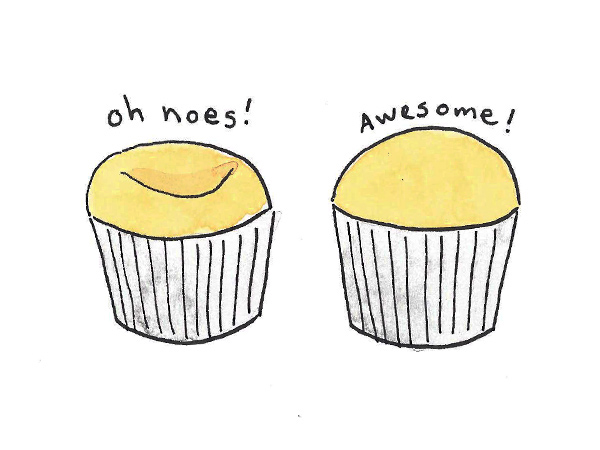Imagine this: You’ve whipped up a seemingly perfect batch of cake batter, poured it carefully in your cake pan and placed it in the oven. It starts rising beautifully, but then somewhere along the baking process — in the oven or maybe after it’s been removed — your cake begins to fall flat in the middle. You’ve got a sunken cake on your hands. What went wrong?
With baking know-how, you can learn how to keep a cake from falling.

Photos and illustrations via CakeSpy
There are several potential causes for fallen cakes, and happily, there are also several solutions. Here, we’ll detail some of the common culprits as well as the cures. This will help you troubleshoot and avoid cake calamity in the future so that you have perfect cakes to eat and decorate. As an added bonus, you’ll find ideas for how to salvage a fallen cake so it doesn’t go to waste.

FREE Guide: Baking Essentials for Beginners
Download this FREE PDF guide to master baking essentials, from how & why we cream butter & sift flour to how to store cake.
Possible for causes for a fallen cake

Incorrect moisture
Whether it’s too much or too little, incorrect moisture can cause problems in your cake baking.
If there is too little moisture in a cake, it can fall in the center. However, too much moisture can also affect a cake. This commonly occurs in humid climates, where added moisture can collect naturally in ingredients such as flour. When this occurs, a cake can rise rapidly and then fall during baking.
So how to remedy the moisture levels? Follow the recipe carefully, and when possible, weigh your ingredients rather than measuring by cups. If you live in a humid climate, keep dry ingredients in the freezer to keep humidity from affecting their volume. This will help reduce the margin for error.
Improper mixing
If you forgot to add the eggs at the right time and then added them later figuring “eh, it will be fine,” you might pay the price for your laissez-faire attitude with a fallen cake. Be sure to read the recipe first. Create a clean work area with ingredients pre-cut, prepared and measured. Having them ready to go will help you follow the recipe without stress.
Incorrect oven temperature
Cake caved in? Your oven could be to blame. Even if the temperature is set correctly on the dial, that doesn’t necessarily mean that’s the temperature inside of your oven. Check it periodically with a heatproof thermometer to make sure that the temperature you’ve set it on is actually the temperature inside of the oven.
Note: Most cakes will bake best in the 350 F range (give or take 25 degrees in either direction). If your recipe calls for something much higher or lower, a good recipe should offer an explanation as to why.
Under-baking

The cake may have puffed up and looked golden on top, but when you take it out of the oven it sinks and turns gummy in the middle. You probably didn’t bake long enough. Don’t depend on a visual cue to detect doneness: also insert a skewer or cake tester to make sure it comes out mostly clean.
Poor emulsification
It sounds scientific, but emulsification is pretty easy to understand. Emulsification, in baking, basically amounts to combining and binding two substances that normally wouldn’t adhere: for instance, butter and liquid. If you haven’t creamed your butter mixture enough, then it may curdle when other ingredients are added. Unless it is specified in a recipe that batter “should look curdled”, it probably should not. If it is “weeping” butter or liquid, the mixture is poorly emulsified, and may result in a fallen cake.
Too much leavening

While cakes depend on leaveners for their rise, too much of a good thing can be harmful to the health of a cake. Baking soda and powder are common culprits. Be careful when measuring quantities for baking soda and powder, respectively: It’s easy to accidentally add a tablespoon when you should have added just a teaspoon. This can cause a cake to rise very rapidly in the oven, and then fall dramatically.
Geography
Where in the world are you baking? Is it in a hot, humid climate? Or at a very high altitude? These conditions can affect the outcome of your baking. In hot, humid climates, ingredients such as flour can condense and collect moisture, so store ingredients in the freezer and weigh ingredients to make sure you are adding proper amounts. High altitude baking comes with its own atmospheric issues that make even recipes that are followed to the letter come out flat. Check out this guide to high altitude baking as a great general primer. Many cookbooks also include special instructions for baking specific recipes at high altitude.
Can you salvage a fallen cake?

Yes, it’s possible, as long as the cake is baked through. However, if the cake is under-baked and still batter-like in the middle, there are food safety issues, and it’s safest to throw in the towel and start from scratch. Even if it looks fully baked, do take a small taste of the cake to make sure that another problem, such as too much baking soda, hasn’t imparted an unpleasant flavor on the cake.
If your cake has fallen but is otherwise fine, you can try leveling the cake to even it out. It’s possible that it will still work as a slightly thinner cake level.
If the cake is sunken too far to be used as a cake layer, the cake itself is still appropriate for a myriad of tasty uses, from ice cream topping to the filling for homemade cake pops.

FREE Guide: Baking Essentials for Beginners
Download this FREE PDF guide to master baking essentials, from how & why we cream butter & sift flour to how to store cake.

Share tips, start a discussion or ask one of our experts or other students a question.
No Responses to “Rise to the Occasion: How to Keep a Cake from Falling”